Understand People That Influence Your Product with Stakeholder Mapping Canvas

Without that knowledge, product managers are unable to define the value proposition and product success and may get lost as they navigate through the diverse interests of the different user groups as well as increasingly changing market needs.
Product managers who work on the digital products with multiple stakeholders will certainly benefit from Stakeholder Mapping Canvas - a model that helps to identify and map out the individuals, groups, or organizations with an interest in a given product or initiative. In addition, it allows product managers to understand the degree of interest or needs of specific stakeholders or groups and subsequently plan their engagement strategy more efficiently.
What is a Stakeholder Mapping Canvas?
A Stakeholder Mapping Canvas is a visual representation of the network of stakeholders who impact a given project. It clarifies which stakeholders have high priority and which are less interested in a given project. It’s a product of collaborative work that draws from multiple perspectives.
Understanding and organizing stakeholders and their needs allows product managers to establish meaningful partnerships and achieve relevant buy-in to ensure the project unfolds easily, effectively and on-time. It helps product managers to determine the goals and define success in any project, providing the clarity necessary to achieve it.
What decision makers should we be looking at specifically when mapping the relevant stakeholders? There are four key areas to take under consideration:
Clients
Or, more broadly speaking: the target group - those who will decide to buy the product, as well as those we would like to convince to purchase it from us. We can look at specific customers and users, as well as entire segments.
Internal stakeholders (staff members)
Whose support do we need, and who are we supporting throughout the product development process? Consider what impact the project has on Sales, Marketing, Product, Research, Design, Engineering, Data, Project Management, Customer Success, Support, People/HR, Legal, Security Teams and any other you deem relevant. How do these departments influence the project as well? Think as broadly as possible.
Partners and external stakeholders
This group entails any entity or person that can help us achieve the product-related goals. Consider the sponsor, investors, subject-matter experts, key business and technological partners, and suppliers on which the project depends.
Other stakeholders
The group includes competitors, influencers, NGOs, government authorities, political parties, communities, and even friends and families - anyone who may be impacted on the product or project but won’t necessarily help us shape it.
A Stakeholder Mapping Canvas is of particular interest to the product manager and the entire product team responsible for creating the right product - one that meets customer requirements and solves problems within each customer segment on the one hand, and fulfills business needs on the other.
The benefits of using a Stakeholder Mapping Canvas
Each product is typically shaped by multiple persons and entities with a vested interest in it. A varying level of influence adds complexity to the picture - some stakeholders will have high interest, others relatively low interest. A Stakeholder Mapping Canvas can help:
- Organize and manage expectations and the risks involved
- Develop an understanding of the people and organizations that revolve around the product and demand success
- Identify subject-matter experts
- Identify actual and potential supporters, as well as those that may potentially sabotage the project and the product itself
- Create meaningful and relevant partnerships
- Execute an effective engagement strategy and communication plan that, ultimately, maximizes the probability of success
- Significantly speed up product delivery by making it easier to know when and with whom we should engage
What challenges does Stakeholder Mapping solve?
Product managers may be challenged by the need to negotiate certain needs, initiatives, and requirements with different stakeholders. The Canvas is the best way to explore stakeholder characteristics and to work out a communication plan that best influences them. It offers:
- An easy-to-digest visual identification of people and entities that directly and indirectly influence a product
- Insights into stakeholder demands and requirements
- Insights into the importance of that influence in the case of every stakeholder or stakeholder group
- A list of partners, suppliers and 3rd party services that are indispensable to developing and releasing the product
- A visual map of connections between the different stakeholders
Managing stakeholder risks
A Stakeholder Mapping Canvas is not just for managing expectations and building relevant and meaningful partnerships. It’s also essential to identifying and managing project risks. These typically include:
- Communication risks: these occur when the product team doesn’t have a thorough understanding of who should be informed about the key developments and why. It’s indispensable to keep the relevant internal teams up-to-date at all times and create a shared understanding of the project and product goals.
- Knowledge risks: mapping stakeholders will help you grasp the missing gaps in case a stakeholder is unavailable. On the other hand, it also helps to precisely recognize what kind of expertise will be required to deliver the product.
- Information overload: the canvas will help you plan and prioritize the right amount of meetings and organize information so that it can be distributed in a comprehensive way. Also, it clarifies the responsibility for information distribution.
- Availability risks: with a Stakeholder Mapping Canvas, your teams won’t have to search for information and will know who to approach for materials or access at all times.
- Resources risks: the canvas helps to identify, plan and secure resources required to complete a project or grow and scale our product.
Creating a Stakeholder Mapping Canvas - step by step
By now, you have likely decided that a Stakeholder Mapping Canvas is what you need. Where do you start? Follow these four steps and you will surely increase your chances for product success.
Step 1: Identification
Begin by listing all the stakeholders that are important to your business, and those that most likely will impact the product’s objectives and overall success. Note that these stakeholders may change as your environment evolves. You can visualize the data with a set of sticky notes (one for each stakeholder).
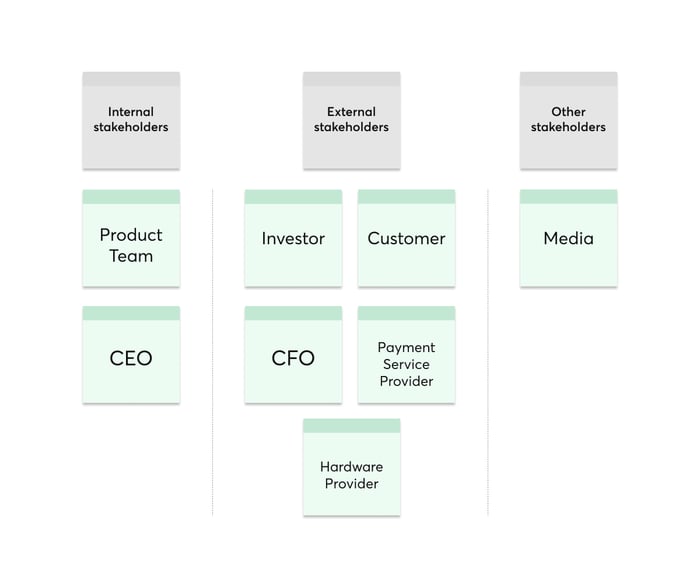
Step 2: Analysis
Analyze each stakeholder in terms of their type, relevance to the business, their needs and the perspectives they can offer. It will help you understand their relationship to the product and to each other.
Assign priority to each stakeholder based on their importance to the product and related projects. You can visualize this data in a simple two-dimensional spreadsheet, listing all stakeholders and relevant information about them.
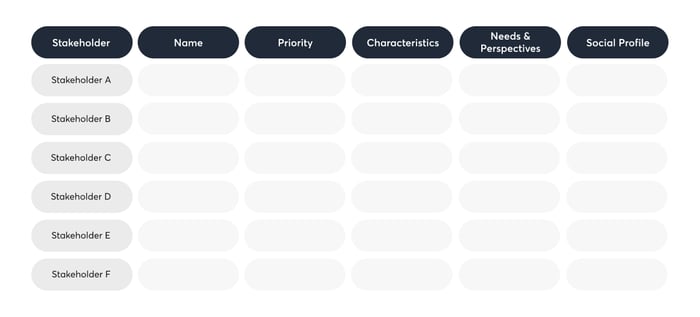
Step 3: Prioritization
With the information collected at Analysis stage, you can now create an Influence/Interest Matrix. Choose different colors to identify the key players you should be working with closely at all times.
Those whose needs should be met in order to keep them satisfied, and those who should be shown consideration by being informed and consulted about how the project unfolds and finally - those stakeholders that are least important from the project’s perspective and can just be monitored. Be strategic and clear about whom you are going to engage with and why.
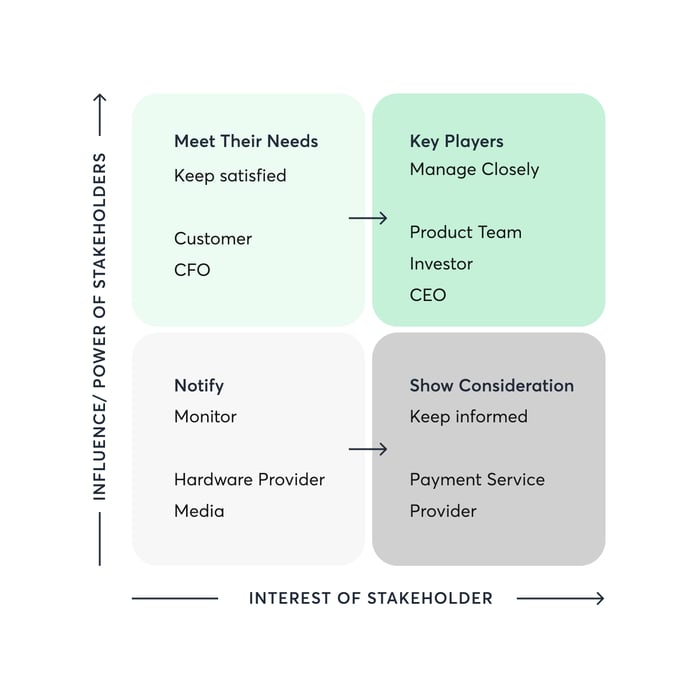
Step 4: Mapping
Apply the players to the stakeholder map template, baring in mind what you have determined in the previous steps. This will indicate the stakeholders that are the most essential to engage with and how. Placing that stakeholders on the canvas will clearly show the level of influence on the product.
Product managers will have to ensure the product meets the requirements of the ‘Key’ players and takes into account the needs of the ‘Important’ ones. All remaining stakeholders fall into the ‘Interesting’ category and are less important to the product, so their needs do not have to be met.
This exercise allows you to understand who are the key stakeholders and to evaluate them against each other. Figure out and map their relationships.
The following questions may be helpful during this exercise:
- Which stakeholders are connected already?
- Which stakeholders aren’t yet connected, even though they should have been?
- Who influences whom?
- Who shares similar interests and agendas?
- Who might oppose each other and be a gatekeeper?
- At what stage of the project do they make decisions?
- How can I get more information on how they make these decisions?
Connect the stakeholders using lines. You can also use emojis to visualize the relationship type or emotions they may represent. A few emojis will be enough, accompanied by a legend to explain what they mean. Visualization will help you understand the complex dynamics between all stakeholders, as well as the dynamics of potential issues and risks.
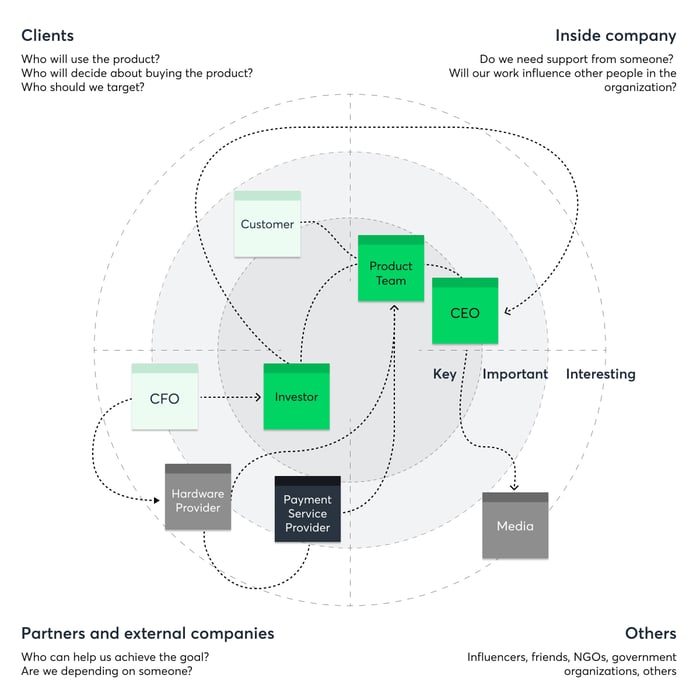
This final step helps to visualize the often complex interplay of issues and relationships created in the criteria defined during the Analysis phase.
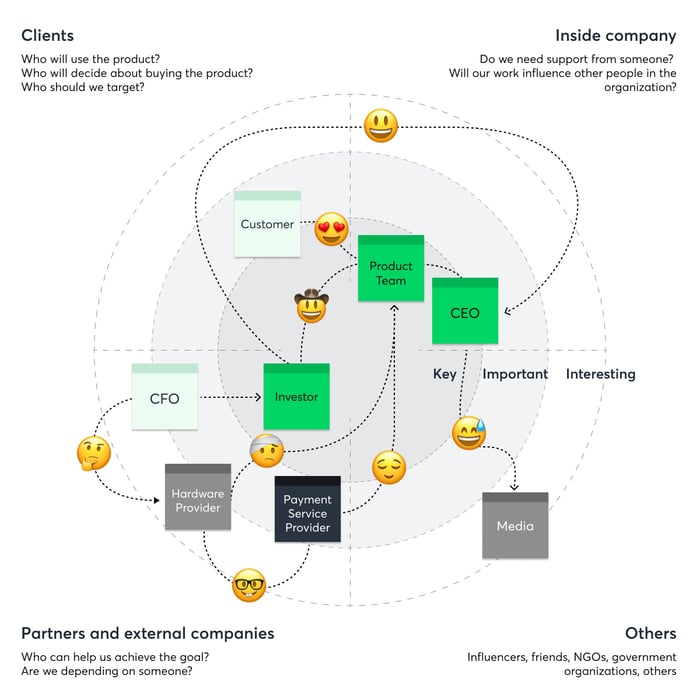
Stakeholder Mapping challenges
Now that you have mapped your stakeholders, we’d like to point out a few issues with this system that you would be aware of:
- A stakeholder’s role in the product may suddenly change, depending on the circumstances. The canvas is a living tool that you may have to periodically revise as the product journey unfolds.
- You may sometimes miss out on important key players. Work on the canvas with a cross-functional group of company’s internal and external stakeholders, even those that may seem irrelevant at first. This guarantees the assessment is carried out in a more informed and thorough manner.
- There may be a miscommunication with regards to several areas of the product, its goals and details. Clarify them with the stakeholders repeatedly to avoid misunderstandings.
Our final tips
A Stakeholder Mapping Canvas will be most helpful if you prepare it at the very outset of the project, so that you can build trust with key players effectively, early on. Having a thorough understanding of the stakeholder relationships and their dynamics ultimately helps to save both time and money. Here’s how to maximize the benefits of the Stakeholder Mapping Canvas:
- For the key stakeholders, you might want to create personas with detailed characteristics and information like their position, company, photo and social profile.
- Revise the Stakeholder Mapping Canvas on a regular basis. Over time, stakeholders and their points of view change. Revisit the map to figure out what the most likely scenarios are, especially when critical decisions are about to be made.
- Research the sentiment of each stakeholder group towards the project. Are they actively supportive, unsure, skeptical, or perhaps against the project? Understanding their attitude will help you determine what actions to take in order to shift unfavorable sentiments to the positive side.
With the above, you will be able to design an effective engagement strategy and relevant communication channels that will maximize the chances of success throughout the product journey.








